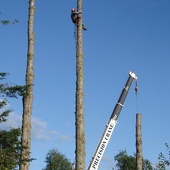Fly through any link on page to see DigLynden's website!
Low overhead
means aggressive pricing to you.
You won't be able to tell we where there.
As a company we do everything from light pruning to close quarter dangerous removal.
DigLynden can contract the entire job.
Tree removal, chipping, timber marketing, clean-up and stump grinding.
Resources for Tree Care and Products:
Plant a tree Bellingham
In Bellingham - Online Shopping for Saw equipment
In Bellingham WesSpur Climbing Gear
By Jodi Zirbel
Pitch canker, Fusarium subglutinans A disease of pine trees, pitch canker is caused by the fungusFusarium circinatum. The first signs of the fungal disease are often wilting of the tips of branches, causing the needles to turn yellow, which is then followed by red. This is called the flagging or reddening of infected shoots. These shoots may also have an over-abundance of resin, or pitch, at the infection area, causing the needles to remain hanging on infected trees long after tissue death. The pitch canker fungus requires a wound to gain entry into tissue, and is spread by bark, cone or twig insect feeding, or breakage of tips and twigs following turbulent weather. Host material and range Pine pitch canker is thought to have originated in Mexico before moving into the southeastern United States in 1946, where it is commonly found on both slash and loblolly pine trees. Forty years later, in 1986, the disease was detected for the first time inCalifornia at New Brighton State Beach in Santa Cruz County. Native Monterey pines have been the hardest hit western pine tree species. Since its arrival in California, pitch canker quickly spread through the state, as well as other parts of the world. The disease prefers mild, coastal climates and has been detected in Japan, South Africa and certain areas of Europe.
Pine pitch canker can affect most every part of the tree, including shoots, branches and the trunk. From what is known, the disease is not systemic, but rather every lesion is thought to cause a local unique infection site. These dead branch tips provide the inoculum or spores to re-infect additional parts within the same or nearby trees. Often the first sign of infection is the loss of needles on unshaded branches, along with female cones falling from the tree prematurely. Due to the significant number of infected branch tips, advanced symptoms include major crown dieback, which ultimately leads to the loss of the treetop and, quite possibly, the entire tree. Because pine pitch canker pine can be fatal, the risk to Christmas tree farms and the commercial timber market is a very real and substantial threat. Perhaps the biggest, most recent, threat is the rate at which the disease is moving and its ability to transform -- inflicting damage to other tree species. The disease spread through California in six short years, and in just 20 years managed to spread worldwide. In addition, although Monterey pines have been the most widely affected, the disease also impairs other western pine species such as Torrey pines, and has even crossed over to other species such as Douglas fir. Prevention tips Since it is not uncommon to find completely unaffected Monterey pines standing amid a stand of diseased trees, one of the most promising prevention techniques is the development and cultivation of disease-resistant trees. The other vital prevention technique is the stoppage of the pathogen, which transports the fungus. Use caution when moving diseased wood pieces -- the fungus can live for up to 12 months in wood -- and be aware that it survives in the soil for at least six months. Treatment tips Examine trees for signs of infection, and prune dead and declining areas to minimize breeding material for beetles that transport the fungus. In addition, some studies have shown that applying a wound dressing to a recently pruned area of the tree, along with a fungicide or insecticide treatment, can help to reduce the reoccurrence of pitch canker. Look for fungicide treatments containing Debacarb, thiabenzadole or benomyl; or insecticide treatments containing Abamectin or imidacloprid. Recent trials using either bark sprays or trunk injections with potassium phosphites have also shown to be effective. What can you do? Monitor trees in spring and early fall to look for signs of infestation. If detected, quickly remove the infected areas and carefully dispose of diseased remnants. Jodi Zirbel is with Epic Creative, Wis. Article provided by Mauget, a leader in micro-injection and micro-infusion tree care. Contact Mauget or visit www.Mauget.com to learn more about pine pitch canker.
Issue Date: Jan/Feb AA 2011, Posted On: 3/7/2011
Pest of the Month: Pine Pitch Canker Article found on Arborage.com

What does it look like?

Photo by Robert L. Anderson, USDA ForestService, Bugwood.org
Current threat

Pitch canker, Fusarium subglutinans
Photo by L.D. Dwinell, USDA Forest Service, Bugwood.org

Comments(0)